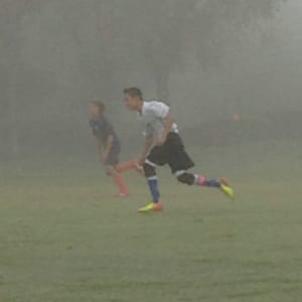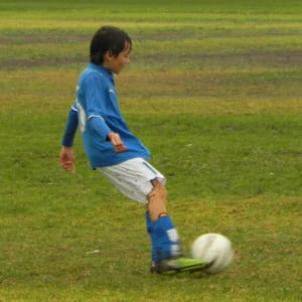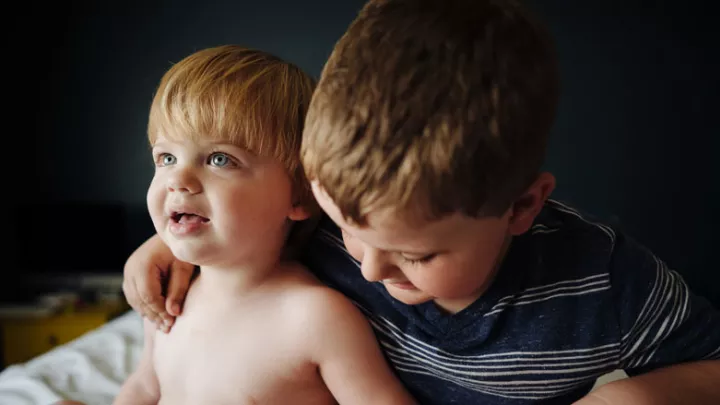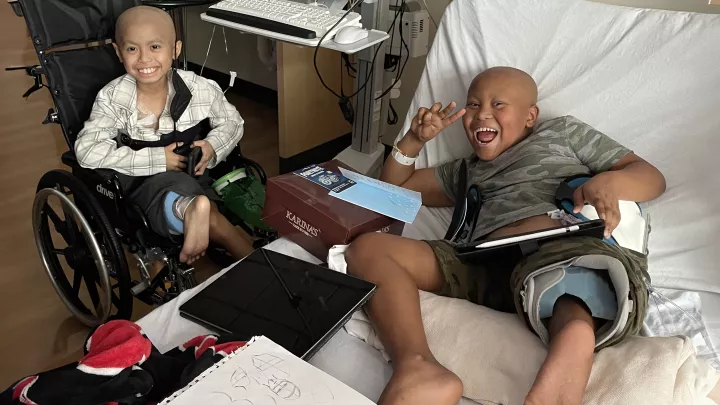Jacob Torres Takes One More Shot
From inside her son’s examination room at Children’s Hospital Los Angeles, Teresa Torres could hear orthopedic surgeon Lee Pace, MD, stop short at the door when he saw the name on the chart. “Wait, what?” she heard him say. “Jacob? No way. No. Way.”
She knew he was about to make an unfortunate discovery: Way.
For the third time in two years, her son was seeing Pace for a torn meniscus suffered while playing soccer, and this time, Pace would come to explain, he couldn’t fix it. But he knew of a solution that might be just as good.
In the beginning, a misdiagnosis
How Jacob Torres got to be sitting in Lee Pace’s office in spring 2015 for a third time is a story so improbable, so star-crossed, so cruel, but on the back end so hopeful—not to mention so darn long—it may be best to begin like this: There once was a boy named Jacob, and he played soccer.
In fact, that’s virtually all he did from age 4, when his parents entered him in his first youth league; when he was 8, seeing Jacob’s ability, they started him in club soccer. Posters, banners and flags of his favorite players and teams drape his bedroom walls in the family’s home in Pomona.
“Playing soccer was all I really knew how to do,” he says. “I tried baseball a couple of years.” He laughs. “It didn’t work out at all.”

During a club game in 2013, he came down hard on his right knee and found that he couldn’t straighten his leg.
Teresa got him to an orthopedist referred by her insurance carrier, which she would see in retrospect wasn’t the best course. “We walked into the waiting room and it was a bunch of elderly patients,” she says. “I probably should’ve taken that as a signal.”
The injury was diagnosed as a subluxing patella—the kneecap came out of joint—and Jacob was prescribed physical therapy. Ongoing pain brought him back to the office multiple times, but the doctor didn’t order any further imaging. He forgot the old adage about assuming. “He was dead-set that it was a subluxing patella,” Teresa says. “That I will always regret—not pushing for the MRI.”
On the soccer field, Jacob’s knee would regularly lock up. “He’d hop off to the side of the field,” his father, Mike Torres, says, “and pop it back—we’d hear it—and he’d go back and play.”
Little did he know that he was pushing his own dislodged meniscus back into place.
After yet another awkward landing, the knee stayed locked and bent. Teresa abandoned her original course and consulted Google. A search for “pediatric orthopedist” turned up Bianca Edison, MD, an attending physician in the Sports Medicine Program within CHLA’s Children’s Orthopedic Center.
Edison took an MRI, identified a tear in the meniscus—a wedge of cartilage in the knee that provides padding between the femur and tibia—and sent Jacob to see Pace for evaluation. The meniscus was not only torn but had flopped out of place, in front of the femur, what’s labeled a “bucket handle” tear because of the pattern it forms.
Pace reset it surgically and came away optimistic. But there was something off that stayed with him.
“The meniscus quality didn’t look too bad,” he says. “But it was a little bit harder to push back into place than I would’ve thought for a fresh tear. And when I sewed it back into place, the stitches weren’t able to pull it back as easily as I thought they would, either. I kind of just went, ‘Hmm.’”
‘Complete disbelief’
After six months of rehab, Pace cleared Jacob for soccer. “In his first game back, he scored within his first two minutes of being in,” Teresa says. “He tried to do a bicycle kick, and I’m like, ‘What the heck are you doing?’”
But only two weeks after his return, he took a misstep on a muddy field and crumpled his other knee, the left one, with the same result: a torn meniscus.
Another surgery and rehab stint ensued, but this one went conventionally and the knee healed “beautifully,” Edison says, because they acted on it promptly, which is critical to recovery. “It’s the one injury that I’ll call Dr. Pace on the phone and say, ‘I have this. When can I get them in to see you?’”
In Jacob’s case, Edison read his MRI on a Monday and he was in surgery with Pace that Friday.
What appeared to be just arbitrary bad luck began to seem like a hex, as on the eve of returning to his team—“literally within 12 hours,” Teresa says, of the next morning’s practice—he blew out the meniscus in his right knee for a second time while playing soccer with friends.
She raced Jacob back to Edison. “I was in complete disbelief,” Edison says. “And it made me sad, too.” She told the family that Jacob’s knee may simply be unable to tolerate the force placed on it by soccer.
“I was in shock,” Jacob says. “I didn’t think I was ever going to play again. I didn’t know what I was going to do with myself.”
Full disclosure
Enter Pace, who after getting past the astonishment of seeing Jacob in his clinic a third time felt the twinge of suspicion that struck him after the first surgery resurface as Jacob and his mother recounted the timeline of Jacob’s injuries, which a year earlier they had not fully explained. That was the first Pace learned that Jacob hurt himself a year before his initial visit to Edison, that no MRI was ever taken, and that throughout the ensuing months he felt something “sliding” back and forth in his knee.
With the new information, Pace concluded the initial meniscus tear had sat unattended for a full year before Jacob was seen at CHLA, compromising the repair job.
“That was when I fully really realized the amount of time that had gone with him not being treated appropriately,” Pace says. So the knee didn’t really re-tear. “Basically, it never healed in the first place.”
Going back in surgically, Pace found the meniscus was beyond rescuing. “When you have a meniscus tear that’s torn and flopping around, it’s going to chew up cartilage and cause the knee to lock and swell. At that point your hand is forced. You just have to remove it.”
But Pace offered some good news, too. Jacob had enough healthy tissue in the area to support a meniscus transplant, to replace the one he had just lost.
Pace is one of the few surgeons in Los Angeles who does meniscus transplants, and the only one who performs them on kids. It’s a complex procedure that requires obtaining donor meniscus tissue that is the right size and age. He does about eight a year, and says only one has failed to hold, which he attributes to an autoimmune disorder the patient didn’t disclose until long after the surgery.
“I don’t even think it’s a question,” he says about the surgery’s dependability. “Our anticipation,” he says, “is to get the kid back to a high level of activity.”
The procedure has become so routine that Pace forgets until well into the conversation that he just came from one. “It’s funny, I didn’t think about this till now—I did a meniscus transplant today. I have another one coming up next month, and another one the month after that.”
Because of the nature of Jacob’s injury—a loss of the lateral meniscus—Pace advocated for a transplant. Leaving things alone would make arthritis inevitable. “When you lose all the meniscus on the lateral side of the knee, your chance of getting arthritis in 10 years is basically 100 percent,” he says. Jacob is 16. “That would put that kid in his 20s with arthritis.”
That wasn’t something Teresa couldn’t bear. “We just felt we had to do it,” she says. “I couldn’t risk his having osteoarthritis by the time he’s 20.”
Pace’s confidence in the procedure was persuasive, even to the weary patient.
“I felt numb to the idea that I kept getting surgeries,” Jacob says. “But I was excited because it was hopefully going to be my last one.”
Waiting for clearance
Pace performed the meniscus transplant in August 2015 and with the family established a year-long rehab program. At the six-month mark, thanks to twice-a-week sessions in CHLA’s John C. Wilson, Jr., Motion and Sports Analysis Laboratory, Jacob hit all the benchmarks, including muscle size, range of motion, and absence of pain or swelling. He would be reevaluated at 12 months.
“I want to make sure he’s got all his strength back,” Pace says. “If I feel that he met an appropriate level of rehabilitation, then we can clear him.”
When that happens, Jacob is eyeing tryouts for his high school team. It will be essentially 2 ½ years since he played competitively. He says his skills are intact; he’s less certain about his nerve. “Physically, I feel perfectly fine,” he says. “I don’t want something to happen again because that would probably be it.”
Teresa is still nagged by self-recrimination, wondering if an MRI taken after the initial injury to the right knee would have averted the whole ordeal.

“I wish I could go back and shake myself awake,” she says. “I should have asked more questions, I should have insisted more. I’d tell everybody that if you ever find your child in the same situation, look for the pediatric specialist, because they know what to look for.”
Jacob has been more serene about it. Throughout, Teresa says, he has managed to keep his head free of debilitating why-me questions. “He has never allowed it to get to him like I think it could to somebody else without as strong a spirit.”
It’s not only Jacob who has been deprived of soccer by his injuries. His love for the sport wore off on both parents, neither of whom had any earlier interest in it. His younger brother, Jared, also plays.
“People ask, ‘Are you really going to let him go back out there?’” Teresa says. “If he shows he’s recovered, then yes. The thought of him not playing is devastating.”
“One of my favorite things to do in the world is to watch my boys play,” Mike says. “One year, on my birthday weekend, Teresa asked me, “What do you want to do for your birthday?’ I’m like, ‘I just want to watch them play.’”
His birthday passed in April. He won’t mind at all if Jacob’s gift arrives a little late this year.
How you can help
To help kids just like Jacob, consider making a donation to Children's Hospital Los Angeles. Visit CHLA.org/Donate.


